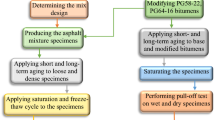Abstract
Despite the environmental and economic benefits of using glasphalt, it suffers from a number of disadvantages. The most common damage in glasphalt is the effect of water on bitumen-aggregate adhesion and the occurrence of moisture damage. One way to improve the resistance of glasphalt against the moisture damage is to use anti-stripping additives. Accordingly, the effect of two types of nanomaterials including nano hydrated lime (NHL) and nano calcium carbonate (NCC) as bitumen modifiers on the moisture sensitivity of glass asphalt has been investigated in this study. The moisture sensitivity of asphalt mixtures was assessed by the AASHTO T283 test and surface free energy (SFE) method. Indirect tensile strength (ITS) results show that the use of waste glass cullet increases and decreases the resistance of asphalt mixture in dry and wet conditions, respectively. An increase in the number of freeze–thaw cycles causes a decrease in the ITS of the glasphalt. The obtained results showed that using both nanomaterials in glasphalt significantly improved the resistance to moisture sensitivity. Bitumen modification using NHL and NCC, which was added in 2% bitumen, reduced the SFE of cohesion, which resulted in improving the bitumen coating on the aggregate surface and the adhesive between bitumen and aggregate.












Similar content being viewed by others
References
Ceran ÖB, Şimşek B, Uygunoğlu T, Şara ON (2019) PVC concrete composites: comparative study with other polymer concrete in terms of mechanical, thermal and electrical properties. J Mate Cycles Waste Manage 21(4):818–828
Wang W et al (2018) Laboratory investigation on high-and low-temperature performances of asphalt mastics modified by waste oil shale ash. J Mater Cycles Waste Manage 20(3):1710–1723
Muniandy R, Ismail DH, Hassim S (2018) Performance of recycled ceramic waste as aggregates in hot mix asphalt (HMA). J Mater Cycles Waste Manage 20(2):844–849
Chai L et al (2019) Mechanical properties of ecological high ductility cementitious composites produced with recycled crumb rubber and recycled asphalt concrete. J Mater Cycles Waste Manage 21(3):488–502
Aktaş B, Bozdemir S (2017) Evaluation of waste slags produced by zinc industry in bituminous hot mixtures. J Mater Cycles Waste Manage 19(1):192–200
Neşer G, Aytekin V (2015) Modification of bitumen-based roof covering material by glass reinforced polyester recyclate. J Mater Cycles Waste Manage 17(3):583–589
Lachance-Tremblay É, Vaillancourt M, Perraton D (2016) Evaluation of the impact of recycled glass on asphalt mixture performances. Road Materials and Pavement Design 17(3):600–618
Kandhal P (1993) Waste materials in hot mix asphalt —an overview. In: Waller H (ed) Use of waste materials in hot-mix asphalt. ASTM International, West Conshohocken, PA, pp 3–16. https://doi.org/10.1520/STP19841S
Maupin GW (1998) Effect of glass concentration on stripping of glasphalt (No. VTRC-98-R30). Virginia Transportation Research Council. Charlottesville, DC, United States
Lachance-Tremblay É et al (2017) Degradation of asphalt mixtures with glass aggregates subjected to freeze-thaw cycles. Cold Reg Sci Technol 141:8–15
Behbahani H et al (2015) Evaluation of performance and moisture sensitivity of glasphalt mixtures modified with nanotechnology zycosoil as an anti-stripping additive. Constr Build Mater 78:60–68
Arabani M, Tahami SA, Taghipoor M (2017) Laboratory investigation of hot mix asphalt containing waste materials. Road Materials Pavement Design 18(3):713–729
Su N, Chen J (2002) Engineering properties of asphalt concrete made with recycled glass. Resour Conserv Recycl 35(4):259–274
Arabani M (2011) Effect of glass cullet on the improvement of the dynamic behaviour of asphalt concrete. Constr Build Mater 25(3):1181–1185
Lottman RP (1982) Predicting moisture-induced damage to asphaltic concrete field evaluation. NCHRP report 246, NCHRP Institute, Washington, DC, United States
Lottman RP (1978) Predicting moisture-induced damage to asphalt concrete. NCHRP report 188, NCHRP Institute, Washington, DC, United States
Funding
The authors have received no fund for this manuscript.
Author information
Authors and Affiliations
Corresponding author
Ethics declarations
Conflict of interest
There is no conflict of interest for this manuscript.
Additional information
Publisher's Note
Springer Nature remains neutral with regard to jurisdictional claims in published maps and institutional affiliations.
Rights and permissions
About this article
Cite this article
Saedi, D., Shirmohammadi, H., Hamedi, G.H. et al. The effect of nanomaterials as anti-stripping additives on the moisture sensitivity of glasphalt. J Mater Cycles Waste Manag 22, 1602–1613 (2020). https://doi.org/10.1007/s10163-020-01050-1
Received:
Accepted:
Published:
Issue Date:
DOI: https://doi.org/10.1007/s10163-020-01050-1




